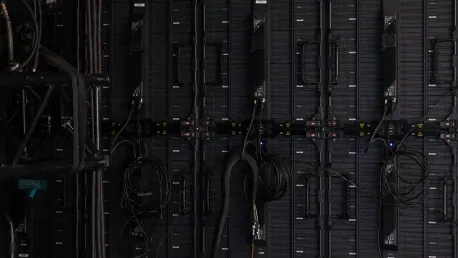India is experiencing a technological transformation that’s extending beyond traditional metropolitan boundaries. As the demand for digital services rises, smaller cities are emerging as the new frontier for data center investments. This shift is driven by several factors, including reduced latency needs, cost-efficiency, and evolving government policies.
The Shift Towards Smaller Cities
Expanding Beyond Metros
India’s data centers were once predominantly based in major urban hubs like Mumbai, Chennai, and Bengaluru. However, the landscape is changing as the need for rapid data processing and digital access permeates into smaller cities. High demand for digital services and the need for efficient data management are prompting corporations and service providers to seek new, viable locations to set up data centers.
Traditionally, the focus was on metros due to their established infrastructure and connectivity. However, the increasing digital penetration in smaller cities demands immediate and localized data processing, pushing data centers to expand beyond the metros. The move to Tier II and Tier III cities is not only about geographic expansion but also about strategically placing data centers to optimize service delivery, enhance user experience, and meet growing data demands more efficiently.
The Role of Edge Computing
Edge computing is pivotal in this transition, with companies like CtrlS pushing the envelope by setting up edge data centers in Tier II and Tier III cities. Edge data centers help in reducing latency, essential for applications in OTT streaming and online gaming. By positioning data processing closer to users, these centers facilitate quicker data transactions, enhancing overall performance.
Edge data centers ensure faster data access and processing by decentralizing major data functions. This decentralization is beneficial in applications that require real-time data processing, such as autonomous vehicles, AI applications, and IoT devices. The strategic placement of edge data centers in smaller cities not only meets local demand effectively but also prepares the digital infrastructure to handle future technological advancements seamlessly.
Key Drivers of the Transition
Cost-Efficiency Factors
Operational costs in smaller cities are substantially lower compared to metros. Affordable real estate, lower labor costs, and reduced power expenditures make these regions attractive to investors. This financial viability allows operators to invest in advanced infrastructure without compromising profitability.
Affordable real estate in these cities provides ample space for large-scale data center facilities. Additionally, the reduced cost of living translates to lower salaries for skilled employees, making workforce expenses significantly lower. These cost benefits make Tier II and Tier III cities practical and economically sensible options for expanding data center operations, aligning with businesses’ objectives to maximize returns on investment while maintaining efficiency.
Regulatory Boosts
Data privacy regulations are pushing companies to store data domestically. Establishing data centers in smaller cities helps firms comply with these regulations, ensuring data security and performance optimization. By maintaining proximity to the data source, companies can manage and monitor data more effectively, reducing risks related to data breaches.
The Indian government has laid down laws mandating data localization, which requires data generated within the country to be stored domestically, amplifying the need for local data centers. This regulatory push ensures that regional data remains secure and is managed under national jurisdiction. Establishing data centers in smaller cities enables organizations to adhere to these regulations without the constraints imposed by metropolitan areas’ saturated markets.
Government Incentives and Support
State-Level Initiatives
Governments are playing a crucial role in promoting data center investments in smaller towns. For instance, RailTel is working on establishing edge data centers at various railway locations, including Tier II and Tier III cities. Such projects are aimed at leveraging existing infrastructure while targeting underdeveloped areas to spread the digital transformation further.
These government initiatives create favorable conditions for data centers by providing necessary support, such as infrastructural development and logistical aid. Reliable infrastructure ensures continuous and efficient data processing, supporting the overall goal of resilient and decentralized digital networks.
Subsidies and Financial Incentives
States like Uttar Pradesh offer policies with subsidies, dual power grid supplies, and other incentives that make setting up data centers economically viable for private players. This supportive environment is attracting substantial private investment, facilitating the rapid expansion of data centers to new regions.
Apart from offering financial incentives, state governments are also focusing on developing required infrastructure and technological capabilities. This includes ensuring uninterrupted power and robust internet connectivity, both crucial for data center operations. These efforts align with the broader national goal of cultivating a digitally inclusive economy.
Emerging Market Opportunities
Growing Digital Ecosystem
Industries such as e-commerce, healthcare, and fintech are increasingly focusing on smaller cities, tapping into a burgeoning user base. Data centers are essential for these industries to offer reliable digital services. As these sectors expand, the demand for localized data processing and storage grows exponentially, driving data center investments in these regions.
With increased internet penetration, more users in smaller cities are accessing digital services, creating new opportunities for businesses. Reliable data infrastructure becomes the backbone supporting these digital endeavors, ultimately spurring economic growth and technological adoption in previously underserved areas.
Supporting Underserved Regions
Reliable data infrastructure in smaller cities opens doors for businesses to serve previously underserved markets, driving local economic growth while fostering technological adoption. By ensuring dependable digital services, data centers enable these regions to participate fully in the digital economy.
Businesses can explore new markets and diversify their customer base by venturing into these emerging territories. As these regions evolve digitally, a well-established data infrastructure ensures seamless operations and experiences, supporting long-term technological and economic growth.
Challenges in Smaller Cities
Infrastructure Constraints
One of the main challenges in smaller towns is the inconsistency of essential infrastructure like power supply and fiber connectivity. Overcoming these constraints requires collaboration with local governments and telecom providers. Building robust and reliable infrastructure is crucial for the operational efficiency of data centers.
Data centers require consistent and high-quality power supply to ensure uninterrupted services. Addressing power-related issues involves investing in alternative power sources and backup systems. Similarly, enhancing fiber connectivity demands significant efforts to lay down high-speed internet cables, which requires coordination among various stakeholders, including government bodies and private firms.
Skill Gap
Establishing data centers requires skilled professionals. Companies are addressing this by partnering with educational institutions to develop relevant training programs and generate employment opportunities. These initiatives aim to create a workforce capable of managing advanced data center operations, bridging the existing skill gap.
Collaborations between industry players and educational institutions focus on training students in specific skills, such as data management, IT infrastructure, and cybersecurity. By creating a talent pipeline, these efforts ensure a steady supply of qualified professionals equipped to handle the technical demands of new data centers.
Market Dynamics and ROI Concerns
Demand Uncertainty
Unlike metro areas, smaller cities might witness lower demand from large enterprises. This can affect revenue projections and potential return on investment, posing a risk for stakeholders. Companies need to carefully assess the local demand and market dynamics before committing substantial investments in these regions.
Identifying niche markets and smaller businesses that may benefit from local data centers can help mitigate demand uncertainties. Tailored services targeting specific sectors such as healthcare, e-governance, and regional e-commerce can create steady demand, providing the necessary business case for data center sustainability.
Capital Expenditure
High upfront investments in smaller cities may not always be justified unless there are specific use cases like edge computing or government projects to validate these expenses. This financial challenge requires careful planning and strategic resource allocation to ensure that investments yield expected returns.
Assessing the potential for edge computing applications and aligning investments with government projects can provide a stable revenue stream. Proactive engagement with local businesses to promote data center benefits and services can also help justify the required capital expenditure, ensuring financial feasibility.
Logistics and Supply Chain Issues
Procurement Challenges
Importing hardware and other critical equipment can be slower due to inadequate logistics infrastructure in smaller cities, potentially delaying data center operations. Ensuring a reliable and swift supply chain is vital for the timely setup and maintenance of data centers.
Collaborating with local suppliers and logistics providers can enhance supply chain efficiency. Establishing regional hubs for equipment storage and distribution can also facilitate quicker deployment and minimize delays, ensuring that data center projects progress without hindrance.
Vendor Availability
A limited number of local vendors for maintenance, security, and facility management services necessitates reliance on metro-based vendors, which can further complicate operations. Developing local vendor ecosystems is essential for the smooth functioning of data centers.
Investments in local businesses and training programs can help create a pool of service providers capable of meeting the needs of new data centers. Encouraging metro-based vendors to expand into smaller cities can also bridge the gap, ensuring consistent and reliable services.
Perception and Awareness
User Reluctance
SMEs might be hesitant to migrate to local data centers due to a lack of awareness regarding benefits. There is often resistance to change, driven by concerns over job security. Educating businesses about the advantages of local data centers, such as reduced latency and improved data security, is crucial for overcoming resistance.
Conducting awareness programs, workshops, and seminars can demonstrate the value of data centers in supporting business growth and efficiency. By highlighting success stories and real-world applications, stakeholders can provide tangible evidence of the benefits, encouraging wider adoption.
Investor Hesitancy
Potential investors may be wary due to uncertain demand and slower returns, making it challenging to gather the necessary financial support for data center projects in smaller towns. Building investor confidence requires clear business cases, showcasing robust market analysis and potential growth opportunities.
Transparent communication of market opportunities, coupled with success stories from similar ventures, can alleviate investor concerns. Demonstrating government support and regulatory advantages can further assure potential investors of stable and lucrative investment prospects.
Creating Sustainable Data Centers
Green Initiatives
Smaller cities offer opportunities for developing eco-friendly data centers. Utilizing renewable energy sources like solar and wind power aligns with India’s sustainability goals while providing cost-effective solutions. The availability of vast tracts of land allows for the implementation of large-scale green projects.
Green data centers emphasize energy conservation and reduced environmental impact. By integrating renewable energy sources, data centers can reduce dependency on traditional power grids and minimize carbon emissions. This approach aligns with global trends toward sustainability and responsible resource utilization.
Energy-Efficient Designs
Emphasizing energy-efficient architecture and advanced cooling techniques can help reduce the carbon footprint of new data centers, promoting responsible digital growth. Innovative designs and technologies play a pivotal role in ensuring that data centers operate efficiently while minimizing their environmental impact.
Implementing cutting-edge cooling solutions, such as liquid cooling and air economizers, can drastically reduce energy consumption. Designing data centers with energy efficiency in mind from the outset ensures that operations remain sustainable and cost-effective in the long run.
Future Landscape
A Decentralized Digital Hub
The rise of data centers in smaller cities signifies a significant shift towards a more distributed data infrastructure in India. These cities are poised to play a key role in creating a resilient and efficient digital ecosystem. Distributed data centers provide better redundancy, ensuring continuous service even in the face of localized disruptions.
A decentralized approach enhances overall network reliability and speed, essential for catering to the growing digital demands across the country. Smaller cities, by developing robust data infrastructure, contribute to a national grid that supports digital growth and innovation comprehensively.
Collaboration is Key
India is undergoing a technological revolution that’s not just confined to its major cities. The surge in demand for digital services is causing smaller towns and cities to become the next hotspots for data center investments. This trend is propelled by multiple factors like the need for lower latency, cost-effective solutions, and progressive government regulations. Historically, metropolitan areas dominated the digital service sector due to better infrastructure and higher digital literacy. However, smaller cities are now catching up because of the increased proliferation of internet usage and mobile penetration. Additionally, businesses are realizing the benefits of setting up data centers in these emerging locations, which include lower operational costs and reduced congestion. Government initiatives aimed at promoting digital inclusivity and infrastructure development further support this transition. As India’s digital landscape continues to evolve, these smaller cities are poised to play an increasingly vital role, making them attractive destinations for technology investments.









